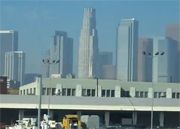
THURSDAY, June 28 (HealthDay News) — People living in and around Los Angeles should brace for more frequent heat waves by the middle of the century, according to a new regional climate study.
Experts from the University of California, Los Angeles, predict climate change will cause parts of Southern California to heat up by an annual average of 4 to 5 degrees Fahrenheit.
Extremely hot days in downtown L.A. will triple in number, and sweltering days in the valleys and mountains will quadruple, the study found.
“The changes our region will face are significant, and we will have to adapt,” study leader Alex Hall, an associate professor in UCLA’s department of atmospheric and oceanic sciences, said in a UCLA news release. Hall is also a lead author of the Intergovernmental Panel on Climate Change reports, which provide assessments for the United Nations.
“Every season of the year in every part of the county will be warmer,” Hall added. “This study lays a foundation for the region to confront climate change. Now that we have real numbers, we can talk about adaptation.”
To make their predictions, the researchers looked at 22 global climate models, each with their own assumptions about how to predict climate change or future greenhouse gas emissions. Once the models were recalculated at the local level, the investigators analyzed and integrated the results to come up with the forecast for the greater Los Angeles region.
The data they analyzed covered Los Angeles and the surrounding areas 30 to 60 miles outside the city, including Palm Springs, Bakersfield and Santa Barbara. A grid was placed on this region, dividing it into squares 1.2 miles across to provide separate temperature predictions for every square.
In looking ahead to 2041 to 2060, the UCLA climate experts predicted the following average annual temperature changes:
- Coastal areas will warm an average of 3 to 4 degrees.
- Downtown L.A. will warm up an average of 4 degrees.
- Mountain and desert regions will heat up 4 to 5 degrees.
The researchers said Wrightwood, Big Bear Lake and Palm Springs will have the biggest temperature changes, with an average annual increase of more than 5 degrees Fahrenheit. The number of extremely hot days in Palm Springs will increase from an annual average of 75 to roughly 120, they found.
“Places like Lancaster and Palm Springs are already pretty hot areas, and when you tack on warming of 5 to 6 degrees, that’s a pretty noticeable difference,” said Hall. “If humans are noticing it, so are plants, animals and ecosystems. These places will be qualitatively different than they are now.”
Although success at reducing greenhouse gas emissions could mitigate the effects of climate change on Southern California, the researchers pointed out that even in the best-case scenario, the area will still heat up to about 70 percent of the predicted levels.
The findings provide city officials with the detailed information they need to plan for the future, the researchers said.
The study, conducted in partnership with the Los Angeles Regional Collaborative for Climate Action and Sustainability, was published online at c-change.la.
More information
The U.S. Environmental Protection Agency has more about climate change.

